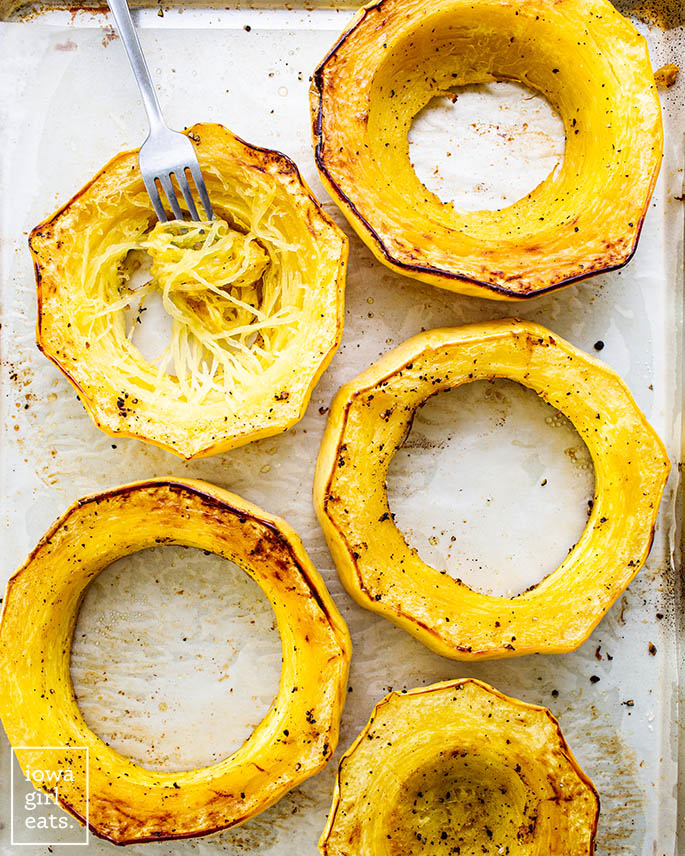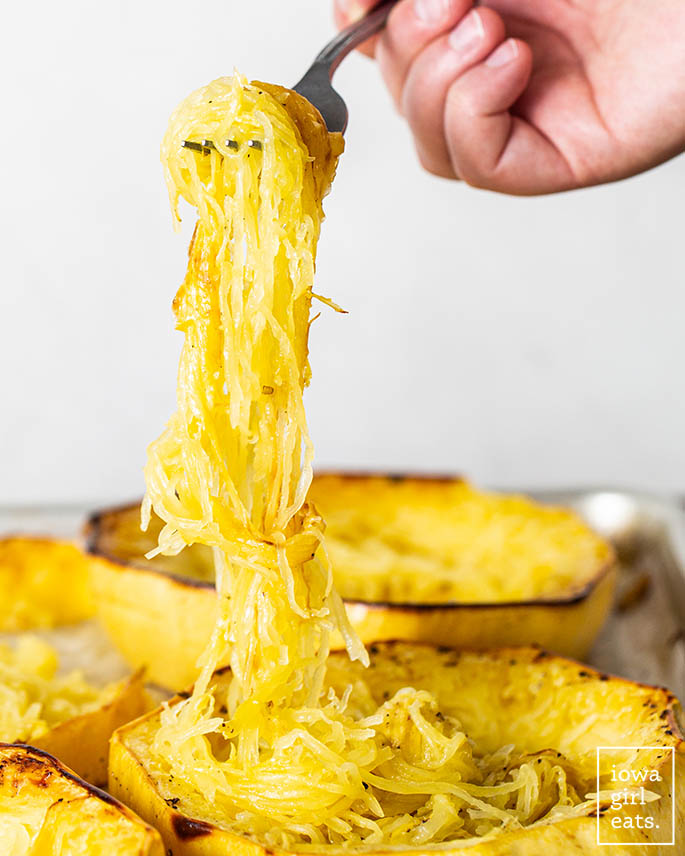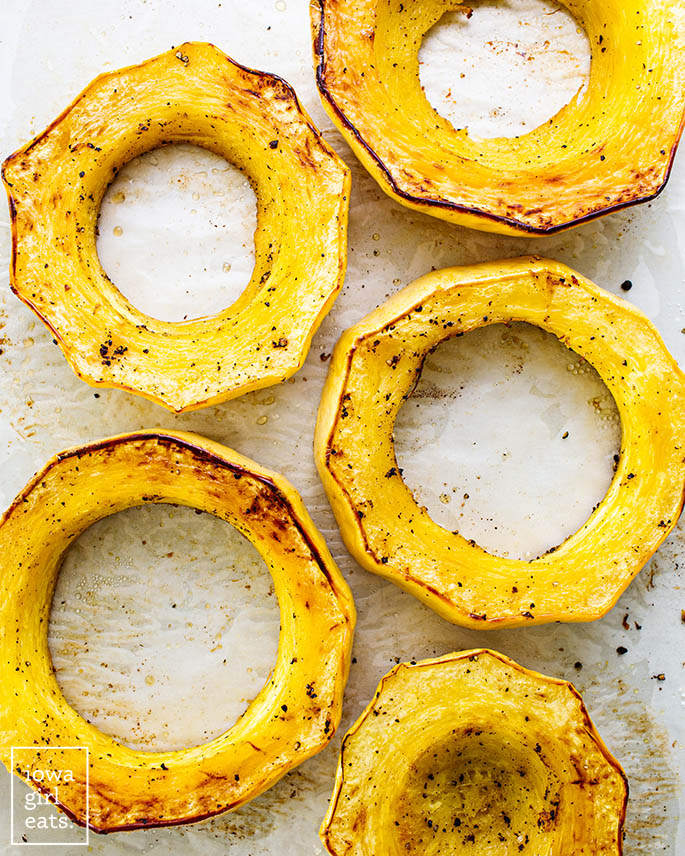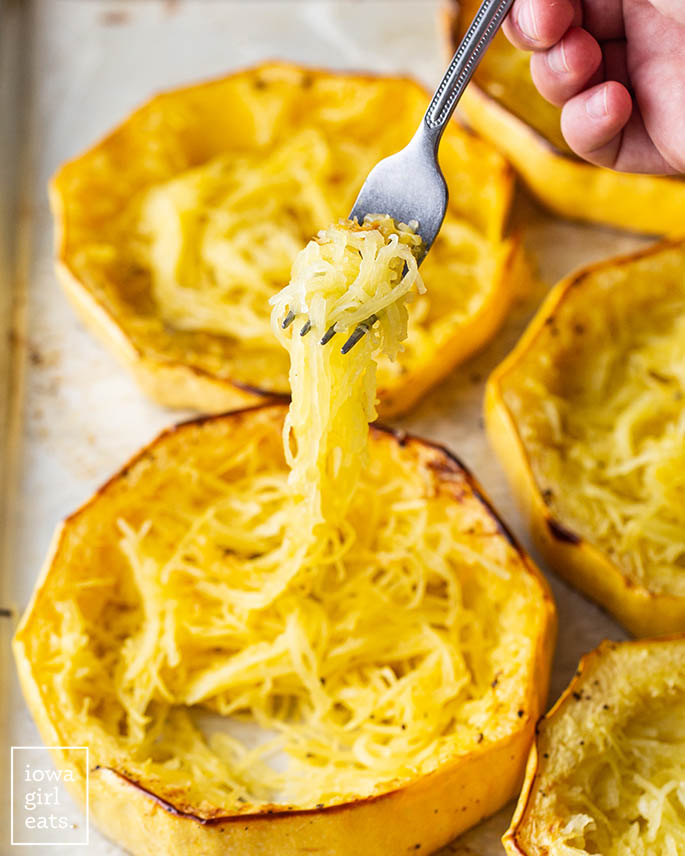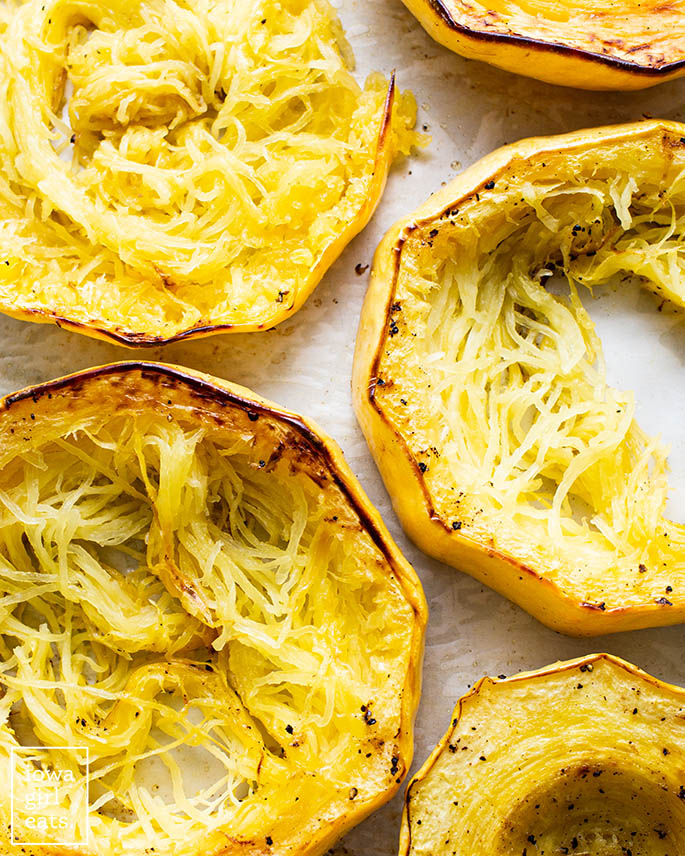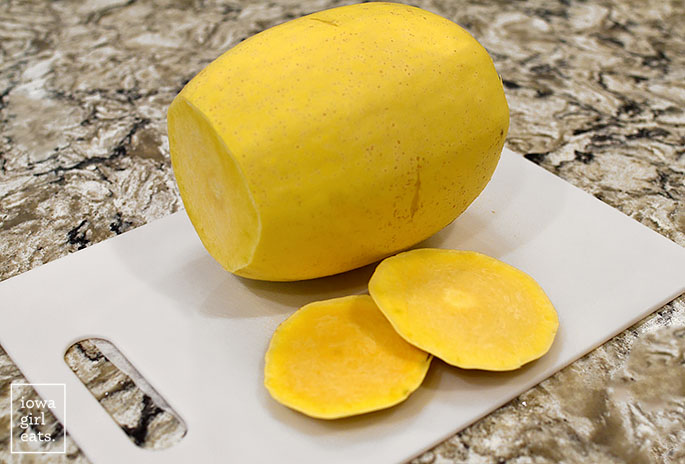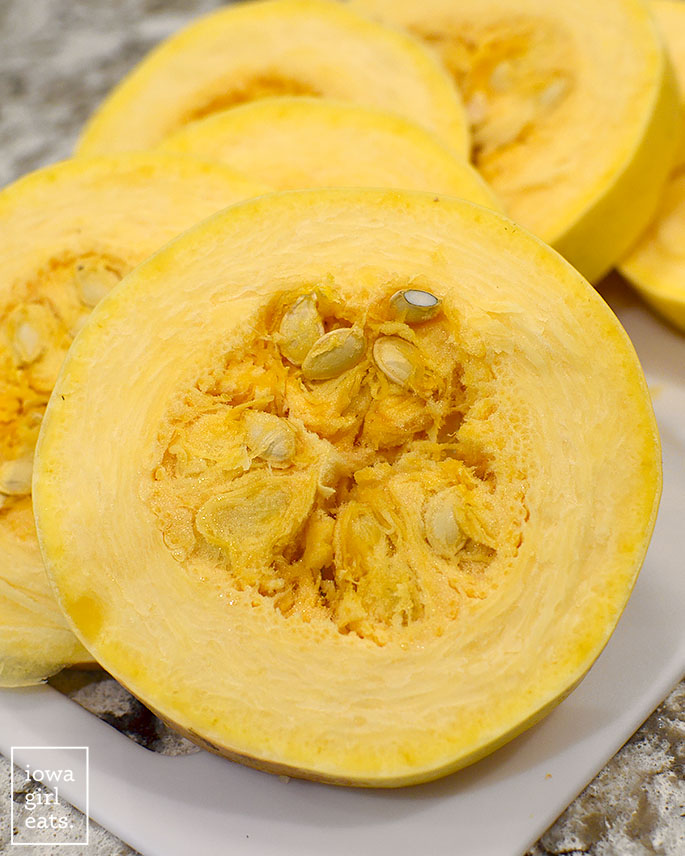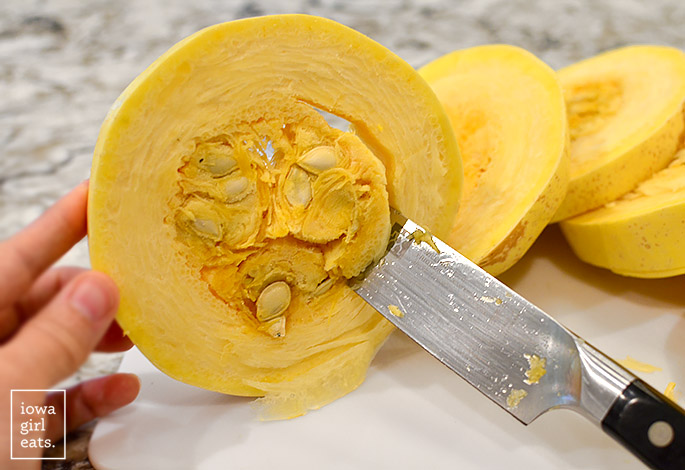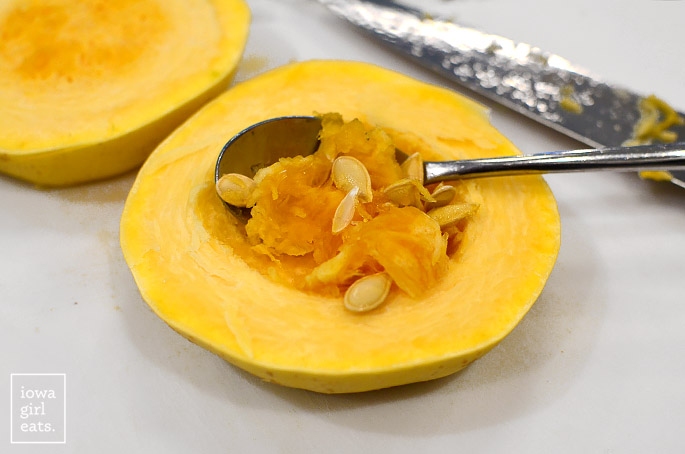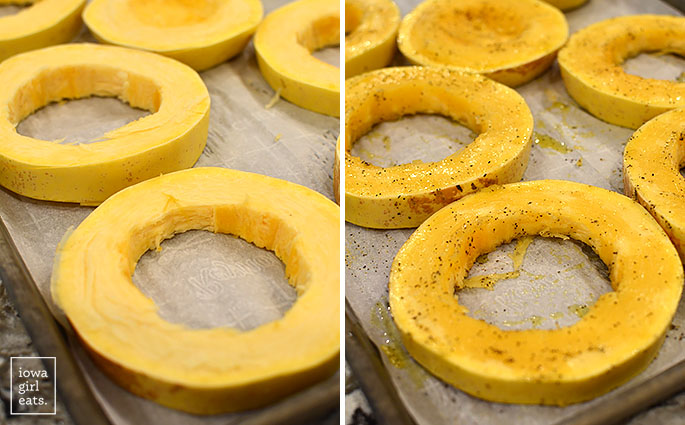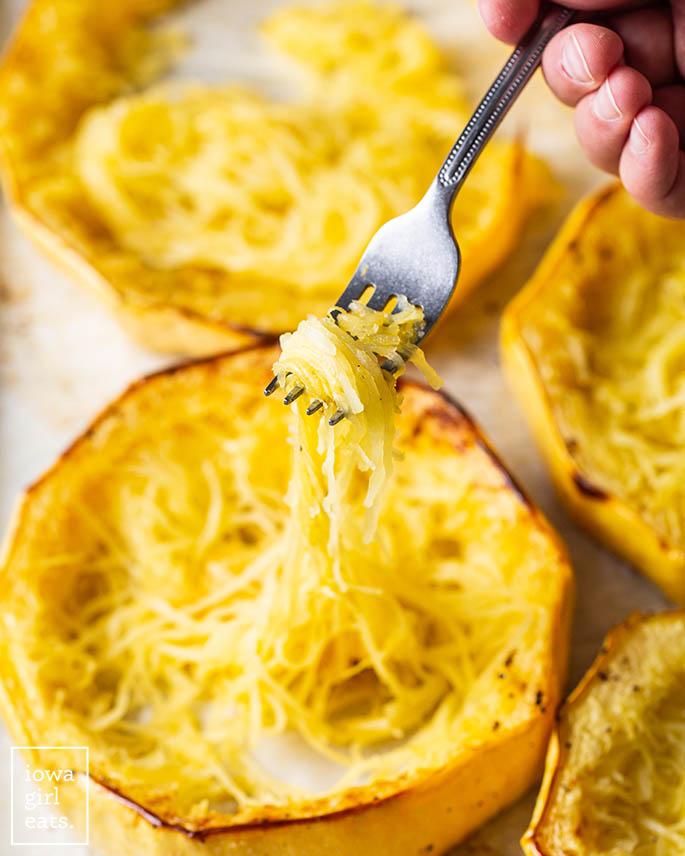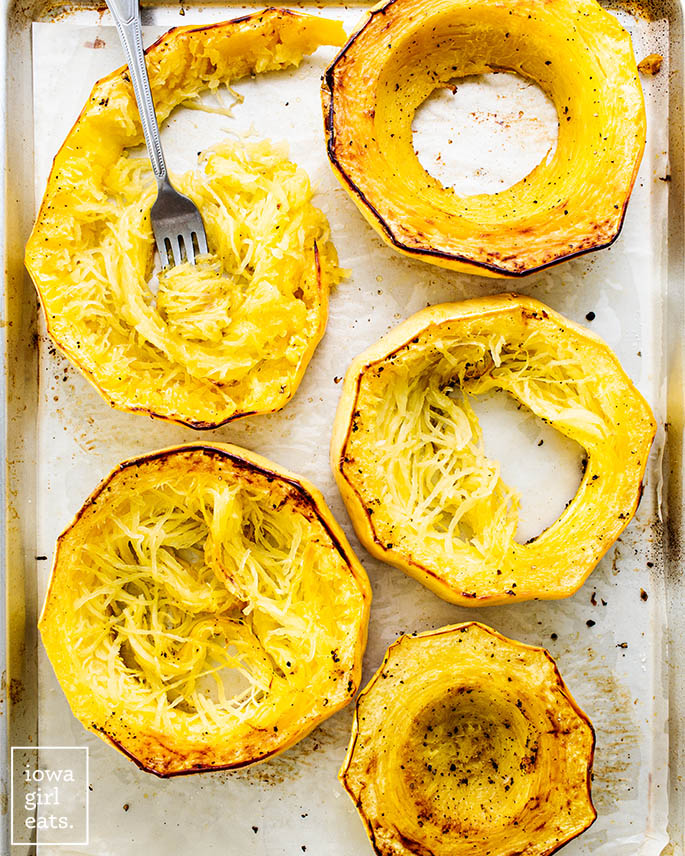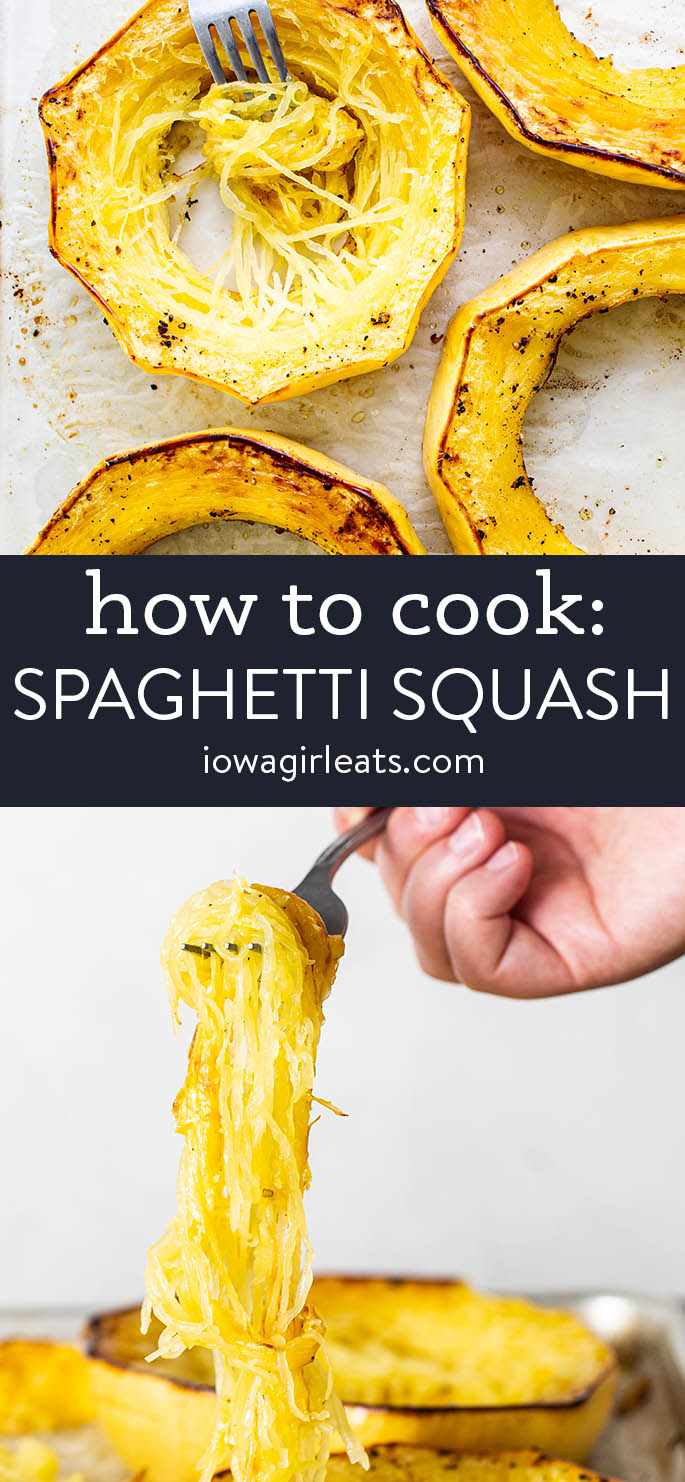My interesting story about spaghetti squash is that one of my spaghetti squash recipes went mega-viral nearly a decade ago, not because it’s incredibly delicious (which it IS) but because Buzzfeed wrote an article about why it should be ashamed of itself. I guess it’s true what they say — there’s no such thing as bad publicity! ;) Point being, I’ve cooked my fair share of spaghetti squash over the years and have landed on the very best way to cook it: slice the spaghetti squash into rings then roast them. The result is spaghetti squash strands that are long like actual spaghetti, crisp-tender vs mushy, plus there’s more surface area to season so each bite is perfectly seasoned. I can’t wait for you to try this BEST method for cooking spaghetti squash!
Watch How to Make It!
What is Spaghetti Squash and What Does it Taste Like?
Spaghetti squash is an oblong squash that’s golden yellow with a mild flavor. That said, it’s a great blank canvas for flavoring with your favorite seasonings and sauces. After spaghetti squash has been cooked, the flesh is shredded with a fork to create long strands that resemble spaghetti. It’s truly a fun food to eat! Spaghetti squash is also low in carbohydrates and calories, high in fiber, vitamins, and minerals, and even has antioxidants, too. We cook it constantly in the fall, especially.
The Best Way to Cut a Spaghetti Squash
Like I said, I’ve landed on slicing the spaghetti squash into rings as the best way to cut it, versus slicing the squash in half lengthwise to create two “boats”. There’s nothing WRONG with slicing spaghetti squash into halves, but there are two main benefits to cutting them into rings instead:
What’s the Best Way to Cook Spaghetti Squash?
Roast it. That’s it, that’s all you need to know, ha! Truly, roasting spaghetti squash not only draws out the moisture from the squash but also caramelizes it for the very best flavor. I think a lot of times when people think of squash, the terms mushy, wet, or soggy come to mind. Drizzling the spaghetti squash with extra virgin olive oil then seasoning with salt, pepper, and garlic powder (or whatever seasonings you like best) and roasting is the best method to produce truly mouthwatering squash with a satisfying, crisp-tender texture.
How Do You Use Cooked Spaghetti Squash?
Whether you roast the spaghetti squash as rings or “boats”, the cooked spaghetti squash strands can be used in a variety of ways. Here are some ideas:
Use the strands as a gluten-free swap for pasta on spaghetti night. Mix the shreds with a touch of butter and parmesan cheese for low carb “Buttered Noodles”. Toss the strands with vegan pesto for as a fresh side dish. Toss with veggies, olives, and feta cheese like in my Very-Veggie Spaghetti Squash. Turn into stuffed spaghetti squash bowls with meatballs, marinara sauce, and cheese as a low-carb option for Meatball Subs. Turn the cooked spaghetti squash halves into a low-carb pizza option (don’t @ me, Buzzfeed!) ;) Use the strands in a satisfying casserole. Serve as is as a healthy, low-carb side for dinner tonight.
Top 5 Tips for Preparing and Cooking Spaghetti Squash
Cooking spaghetti squash isn’t rocket science but since squash has a hard, outer skin that can be hard to slice, I do have 5 important tips for preparing and cooking spaghetti squash. Whether you use roasted spaghetti squash as a gluten free, low carb swap for spaghetti, or simply choose to stand over the baking pan devouring roasty-toasty strands of spaghetti squash straight out of the oven (#beentheredonethat) I know you’re going to love this method for cooking spaghetti squash!
How to Prepare and Cook Spaghetti Squash
Step 1: Pierce then microwave the spaghetti squash.
Start with a large, whole spaghetti squash with unblemished skin. A few scars and spots are fine but avoid a squash with punctures. Use a straight-edged knife like a sharp chef’s knife to pierce the squash 4 or 5 times all the way around the center then microwave for two minutes, rotating the squash halfway through. Piercing the skin ensures that the squash doesn’t explode in the microwave! Let the spaghetti squash cool for a few minutes then place a damp paper towel under a large cutting board to prevent slipping and slice off the top and bottom of the squash.
Tip: this extra step of placing a damp paper towel under your cutting board to prevent it from slipping is truly a game changer. You do not want a slippery cutting board while using a sharp knife to slice a hard squash!
Step 2: Slice the spaghetti squash into 1-1/2″ rings.
Use a rocking motion with your knife while rotating the squash to create 1-1/2″ rings. It’s ok if they’re bigger or smaller than that — just as long as they’re all generally the same size. If your rings are thicker than 1-1/2″, plan on tacking on a bit more baking time. If they’re thinner than that, you will need less baking time.
Step 3: Remove the seeds from each ring.
Insert your knife into the center of each slice then rotate the slice like a steering wheel to cut out the seeds.
For the slices near the ends of the squash, use a spoon to scoop out the goop!
Step 4: Season then roast the spaghetti squash.
Place the spaghetti squash rings onto a baking sheet lined with parchment paper or nonstick-sprayed foil then drizzle each ring with extra virgin olive oil, salt, pepper, and garlic powder (or your favorite seasoning blend — my homemade seasoned salt plus pepper is great too!) Use your fingers to rub the oil and seasonings all over the front and back of the rings, plus the inside and outside of the squash.
Roast the rings for 25-35 minutes or until the flesh shreds easily with a fork. I also like to give the squash a taste test for texture here and there while it’s baking to ensure it’s not over-cooking. Voila — true spaghetti-like strands of spaghetti squash!
How to Store
Use the roasted then shredded spaghetti squash immediately or scoop the strands into an airtight container, cool to room temperature, and then cover with a lid and store in the refrigerator for up to 5 days. Reheat in the microwave if serving as a side dish or topping with sauce. If you’ll be using the spaghetti squash strands in a casserole or stir fry / skillet meal, you can use the strands cold, straight out of the fridge. However you eat it, I hope you love this best method for how to cook spaghetti squash – ENJOY!
Use Cooked Spaghetti Squash in These Recipes
Very-Veggie Spaghetti Squash. Low Carb Spaghetti Squash and Meatballs Pizza Spaghetti Squash Chicken Bacon Ranch Spaghetti Squash Casserole Toss with Vegan Pesto Serve under Shortcut Vegeatble Ragu
Photos by Ashley McLaughlin Like this recipe? Share it with friends!
